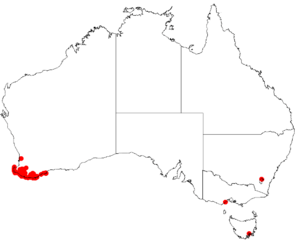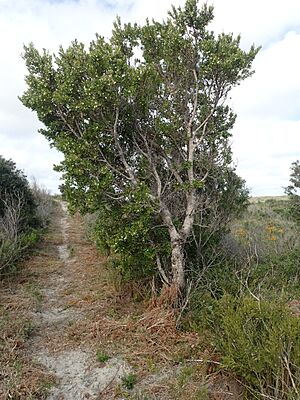Dungyn facts for kids
Quick facts for kids Dungyn |
|
|---|---|
 |
|
| Hakea oleifolia growing on the Bibbulmun Track near Walpole | |
| Scientific classification | |
| Genus: |
Hakea
|
| Species: |
oleifolia
|
 |
|
| Occurrence data from AVH | |
The Dungyn (or olive-leaved hakea) is a unique shrub or tree. It belongs to the Proteacea plant family. This plant grows naturally only in a specific part of Western Australia. You can find it along the south coast in the South West and Great Southern regions.
Contents
What Does it Look Like?
The Dungyn plant is usually an upright, rounded shrub or a small tree. It can grow to be about 2 to 10 meters (6.5 to 33 feet) tall.
Its flowers are large and have a strong, sweet smell. They are white and grow in small groups called racemes. Up to 28 flowers can appear in one group. The Dungyn blooms from August to October.
The leaves look like olive leaves, which is why it's also called the "olive-leaved hakea." They are oval-shaped, about 3 to 9 centimeters (1.2 to 3.5 inches) long. They are usually smooth, but some might have a few small teeth along the edges.
After flowering, the plant produces interesting fruits. These are woody capsules shaped like an egg, about 2 to 3 centimeters (0.8 to 1.2 inches) long. They have two noticeable "horns" at the end.
How it Got its Name
The Dungyn plant was first officially described in 1856 by a scientist named Carl Meisner. The description was published in a scientific journal.
Its scientific name, Hakea oleifolia, tells us something about the plant. "Olea" comes from the word for olive, and "folium" is Latin for leaf. This name was chosen because the leaves of the Dungyn look a lot like the leaves of an olive tree.
Where Does it Grow?
The olive-leaved hakea grows in the wet southwestern tip of Western Australia. You can find it from Busselton all the way to Bremer Bay.
It often grows as an understorey plant, meaning it grows beneath taller trees in woodlands. It also thrives in coastal areas. This plant is tough and can handle salty winds from the ocean. It grows well in different types of soil, including clay, sand, loam, and gravelly soils. It can also survive frost, but it needs soil that drains water well.
Is it Endangered?
The Western Australian Government has looked at the Dungyn plant's population. They have classified Hakea oleifolia as "not threatened." This means there are enough of these plants, and they are not currently at risk of disappearing.
Images for kids



